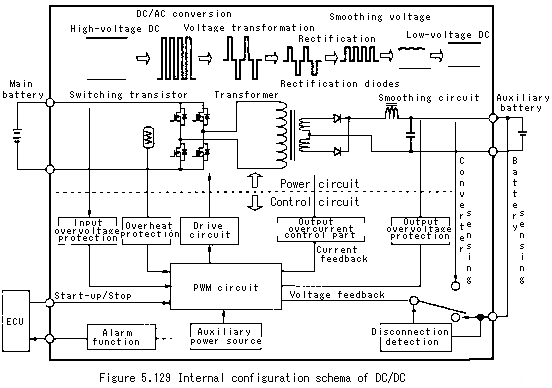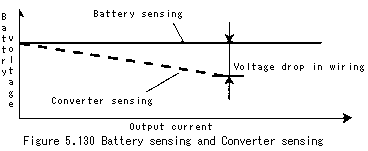| Operating principle and function of DC/DC converter |
|
Operating principle and function
The main internal configuration of the DC/DC converter is shown in Fig. 5. 129. The
DC/DC converter consists of the power circuit and the control circuit, for the power conversion.
In the power circuit, the switching transistor (MOS-FET is mainly used due to the high speed
switching requirement) switches the input DC voltage according to the drive signal from the
control circuit, then supplies the AC voltage to the transformer. The transformer changes the AC
voltage, and rectifies it through the diodes. In the smoothing circuit, the on-off DC voltage
after the rectification is smoothed, and it is then changed in the auxiliary battery.
The control circuit controls the output voltage so as to output the specified voltage even in case
there is a disturbed change in the main battery voltage.Å@The explanation of the sensing voltage
is given here (Fig. 5. 130). The installation of the DC/DC converter and the auxiliary battery
and the wiring method are different depending on vehicle models. Therefore, the voltage drop in
the charging line from the DC/DC converter to the auxiliary battery is not the same.
(In general, the voltage drop is approximately between 0.1V and 0.5V). However, the auxiliary
battery requires a precise voltage charge to it. Since the voltage drop not negligible, the
terminal voltage of the auxiliary battery is detected directly, and then the output voltage is
controlled so that the voltage at the auxiliary battery terminal reaches the specified value.
This is so known "battery sensing control". On the other hand, the abnormal sensing control is
performed in case of an emergency, such as the disconnection of the battery sensing line. In this
case, the sensing point is switched from the auxiliary battery terminal to the output terminal of
the DC/DC converter. This is so known "converter sensing control" (or "local control").
In addition to the above, the control circuit has the following functions.
- Overcurrent control
- Input overvoltage protection, output overvoltage protection
- Overheat protection
- Alarm function


Reference
Book title: EV Handbook
Written by: EV Handbook Publisher's Group
Published by: Maruzen Co., Ltd. (URL http://www.maruzen.co.jp)
|
|